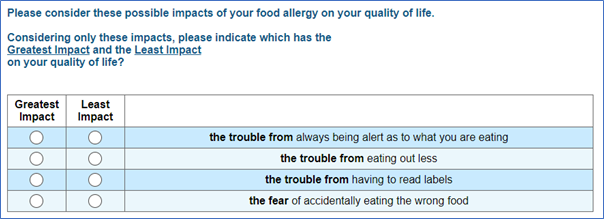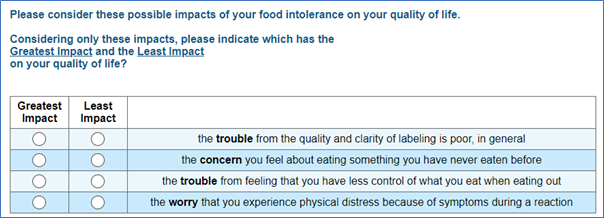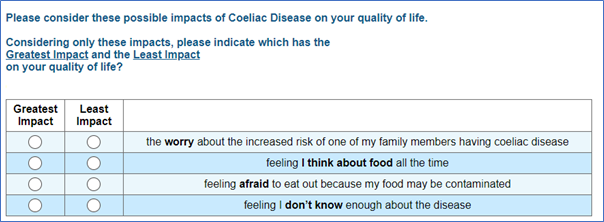Identifying the greatest impacts on quality of life using best worst scaling (bws) Willingness to Pay
How the greatest impacts were identified using the best worst scaling, and what they are
4.1 BWS Overview
A Best Worst Scaling (BWS) component was included within the survey to elicit which of the many impacts of their food hypersensitivity people considered to have the greatest (and least) effect on their quality of life. BWS is a technique designed to elicit relative importance’s.
The impacts considered were those which comprise the condition-specific quality of life measures:
- Food Allergy Quality of Life Questionnaire, FAQLQ
- Food Intolerance Quality of Life Questionnaire, FIQLQ
- Coeliac Disease Quality of Life Questionnaire, CDQ.
Respondents’ responses in the BWS choice sets allow:
- estimation of the relative importance of the impacts of each of the conditions, from the perspective of those living with the conditions
- aid identification of those impacts which are most important to people and within the FSA’s power to affect.
The 29 impacts which comprise the FAQLQ, the 22 which comprise the FIQLQ and the 20 items of the CDQ were (in some cases with modest rephrasing) included in an Best Worst Scaling choice sets. The BWS sets were the product of an experimental design in which the full set of FHS impacts were combined into multiple subsets each comprising 4 of the FHS impacts (see Appendix E for more details).
Example BWS choice sets for the 3 conditions are shown in Figures 4.1 to 4.3
Figure 4.1. Example BWS set: food allergy

Figure 4.2. Example BWS set: food intolerance

Figure 4.3. Example BWS set: coeliac disease

All BWS sets were made up of 4 FHS impacts per set (see Appendix E for more on the experimental design) and respondents were presented with sets relating to the condition that they had identified as the sole, or most significant, food hypersensitivity they had. Because the FAQLQ/FIQLQ/CDQ differ in the number of impacts included, the number of set people completed varied by condition. Food allergy participants completed 10, those with food intolerance completed 8 and those with Coeliac coeliac disease completed 7 sets.
Advantages of the BWS approach include
- BWS shows greater power of discrimination than more established methods such as Likert scales as it forces respondents to discriminate, preventing participants rating many or all of the items at equal importance (Cohen 2003, Cohen and Orme, 2004, Burton et al, 2019)
- as there are no category descriptors scale bias is avoided, for example from differential interpretations of terms such as “slightly”, “moderately” or “quite” (Cohen 2003, Sawtooth Software, 2020)
- participants are better at judging items at extremes of preference or importance (Louviere 1993).